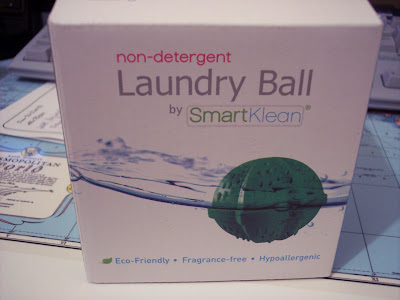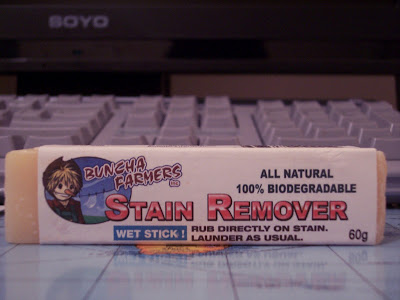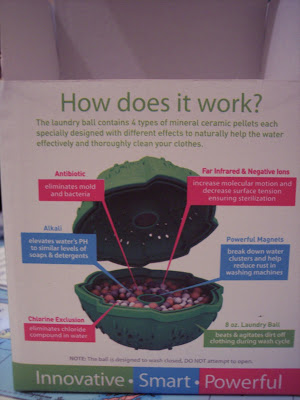
SmartKlean's non-detergent laundry ball was one of the items that caught my eye in this year's Green Living Show. I must have had a look of skepticism when I arrived at the booth, because one of the vendors immediately came up to me to explain how the laundry ball works. My chemistry is a little rusty, so I took it all in with a grain of salt. The booth vendor told me the following things:
1) Typical detergents are able to clean clothes by raising the pH of the water so that it becomes slightly basic. In a basic environment, dirt is less likely to cling to fabrics. The non-detergent laundry ball uses alkali ceramic pellets in the ball itself to physically change the pH of the water by emitting ions that bond with calcium and magnesium ions in the water (these cause acidity in the water), while typical detergents use chemicals harmful to the environment to do the same thing.
2) Typical, chemical detergents also help clean clothes by lowering the surface tension of water. How is this important? Well, let's look at a bit of chemistry first:
Surface tension describes a liquid's resistance to spreading out and increasing its surface area. One of the examples they always show us in chemistry lectures to demonstrate surface tension is a picture of a water strider walking on water. The surface tension of water is such that the water strider finds it difficult to penetrate the water's surface (which is a good thing for the water strider). How does this happen? Molecules underneath the surface of water are completely surrounded by other water molecules with equal attraction in all directions. However, molecules on the surface of water are not completely surrounded, and so the attraction is only downwards, toward the interior of the liquid's body, and in effect, minimizing the liquid's surface area and making penetration of the water's surface a little more difficult.
In effect, lowering the surface tension of water allows it to become a better "wetting agent", since it is less likely to cling to itself, and will be able to get into the pores of clothing more easily. The far-infrared ceramic beads in the non-detergent laundry ball lowers the surface tension of water by emitting negative ions. I'm guessing these negative ions disrupt the structure of the water molecules at the surface and make the attractive forces between them a little more equally distributed.
3) You can use it for about 365 loads.
4) You can skip doing a rinse cycle, since there are no soap residues left after the preliminary wash.
5) You can save a lot of money because hot water is not necessary when using the laundry ball.
I actually passed the booth by, letting them know I would come back sometime later in the day if I decided to buy it. Walking around the rest of the show, I thought about the implications of a non-detergent cleaning solution for everyone living in our house. I guess I also wanted to believe in its ability to clean clothes, and in its supposedly environmental approach to doing laundry. It might have also been pure curiosity. When faced with the possibility of exposing another product of green-washery, I just couldn't help myself. So I ran back, paid the $50 (actually, I got mine for $5 off because I spun the wheel of fortune and got 10% off), and received a bonus stick of Buncha Farmer's All-Natural Stain Remover.
 Anyway, you might not care about all this chemistry mumbo jumbo. You just want to know how it works for me, right? Is it actually a green-washed product? Does it live up to all it claims? Well, verifying some of its claims might be difficult to do without a chemical laboratory, but here are some of my general observations:
Anyway, you might not care about all this chemistry mumbo jumbo. You just want to know how it works for me, right? Is it actually a green-washed product? Does it live up to all it claims? Well, verifying some of its claims might be difficult to do without a chemical laboratory, but here are some of my general observations:1) I actually have less skin allergies now!
2) If someone smokes, the smell of cigarettes sometimes lingers on clothing that has already been washed in the laundry with the SmartKlean laundry ball; however, the smell doesn't cling to other clothes that are in the same wash batch
3) Clothes have a very faint detergent-y smell to them, but that could be from the lingering residue of detergents in the washing machine.
4) The brochure says "one laundry ball [can] be used over and over for 365 loads on the basis of 18 lbs (8.5 kg) of clothes per wash". 8.5 kg is almost the weight of typical carry-on luggage stuffed with clothes and other items. This might actually be less weight than my normal loads, which means I have to do more loads than before. However, because I'm eliminating the rinse cycle, more loads doesn't necessarily mean more water usage.
5) The plastic ball can't be reused after 365 uses (I haven't reached my limit yet). Apparently, we have to buy a new ball instead of just having the ceramic beads/pellets replaced. This was irksome news, but I did think about what could happen with a laundry ball that's able to be opened up. Unless there's a fail-safe lock between the two halves of the ball, there's no guarantee that the beads/pellets will stay inside the ball during a wash. In saying this, however, I have to ask, "Why ISN'T there a fail-safe lock for the laundry ball?" It would be so much more economical, and environmental, for the beads/pellets to be replaced, rather than the whole ball. Even if the old laundry ball is recycled, the manufacturer will still have to destroy/dismantle it, and then make it again with new beads/pellets inside. This requires more energy use, and I'm sure that when plastics of any form are recycled, it's not always 100% recycled. Some of it is lost in the process.
6) If I don't put the laundry ball outside in the sun to dry out the ceramic beads/pellets (recommended by the manufacturer every 10-30 washes), the laundry ball doesn't clean clothes as well as it did before.
 7) Looking at the laundry ball's list of ingredients, I have to question whether the laundry ball is actually safe or not. For example, what is epoxy resin? It sounds like something you'd find in glue. This just means I'll have to do a little more research on the ingredients. Yikes!
7) Looking at the laundry ball's list of ingredients, I have to question whether the laundry ball is actually safe or not. For example, what is epoxy resin? It sounds like something you'd find in glue. This just means I'll have to do a little more research on the ingredients. Yikes!8) In the information sheet that came along with the laundry ball, it claims that adding 1/4 cup of white vinegar and 1/4 cup of sea salt helps keep white clothing bright. I tried this but I found no discernible differences...
So with all these observations, what is my final verdict?
I like the idea of cleaning clothes without the use of detergent because of a number of reasons:
1) I have allergies, and chemicals in detergents aggravate my allergies.
2) Detergents contain phosphates that increase the population of algal blooms in the water. These use up all the oxygen in the water and cause fish and other water creatures to suffocate. Solutions that reduce the amount of phosphates going into the water get a thumbs up from me.
3) Detergents often have a strong smell. I don't like this.
The laundry ball also seems to work (could this be psychological though? I want it to work, and therefore observe only what I want to observe...?), so despite the fact that it costs $50 and you can't replace the beads/pellets yourself, I think the pros might actually outweigh the cons in this product.
Have you tried anything like this before, and how do you feel about it?